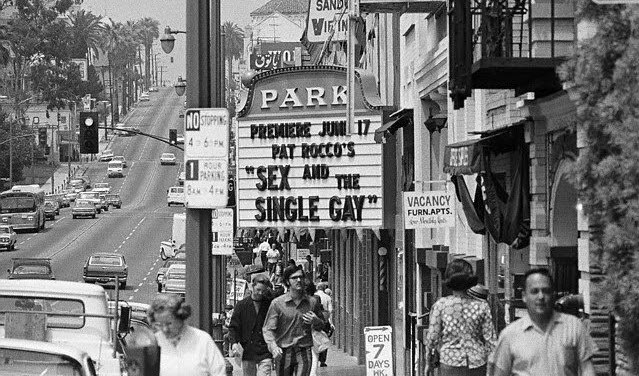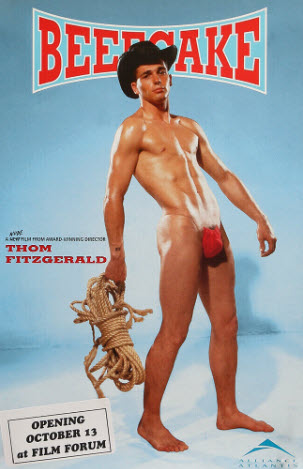Your Guide to the Perfect Summer Look – AMG S/S 2010
A little over a year ago, we received a request from the illustrious men’s magazine, BUTT, for a set of fully clothed models from the Bob Mizer...
6 min read
Bob Mizer Foundation : Jul 7, 2016 4:19:00 PM

A concerned member of the Foundation wrote us in regard to the scanning of the Mizer negatives. He was thinking that these negatives must be scanned NOW. My response shows why that is impossible currently, and that they must be organized and catalogued first, as we are doing. Read on for the full email [edited for length and clarity].
Dear Mr. Bell,
As I was thinking about it, it occurred to me that maybe my donation might be better spent on something else. You see, I'm a retired librarian, and one of my library interests was preservation and conservation of materials. Additionally, I was a teacher during the first years of my career, and I had a strong interest at that time in amateur photography (particularly for classroom use).
Of course, in those years it was FILM, not digital photography, and for me it was exclusively colored slides. To improve my photographic knowledge and skills in those early years, I purchased a lot of booklets that Kodak published on all sorts of aspects of photography. And it's what I learned from some of those booklets that has me greatly concerned.
In a message a month or two ago when you started this campaign, I think you had mentioned that there were 700,000 slides involved in this project. I realize that it's quite possible that many (perhaps even most or all) of the slides are B&W slides, but I'm going to presume (perhaps mistakenly) that most of them are colored slides.
 Here's my concern:
Here's my concern:
Perhaps you've already done this, but it is ABSOLUTELY ESSENTIAL that you digitally scan EVERY colored slide (with a very high resolution film scanner) *NOW*!!! Sorry for all the uppercased words and exclamation points, but it's THAT important! Please pardon me if you already know all this, but B&W film and color film are completely different and cannot be treated the same. Silver-based high quality B&W film will last a very long time (and I mean around 100-500 years) if you take care of it as you have been doing. B&W movie film could be "iffy" depending on what the film is made of. (You may be aware that a lot of the pre-1950 B&W motion pictures, especially the older ones, suffered either from "melting" into a solid mass of goo or from easily or spontaneously catching fire because of what the film was made of. Hollywood had to do a lot of transfers onto modern "safety film" before they lost their film vaults.) I have no idea what kind of movie film Bob Mizer used. It's something you should check, if you haven't already.
However, my greatest concern is with color film, most especially color slides. You see, buying all those protective sleeves for color slides isn't going to do much good if there's little or no image there, say, 20-30 years or more from now. All color film depends on DYES for the color--and dyes change and fade over time. That's not a maybe--that's a guarantee. Kodak said so in those booklets I mentioned. They even showed graphs of how each of the three dye colors change DIFFERENTLY over time, thus gradually changing all of the colors on each slide. (You may have noticed how unrestored old color movies from the 1950s or so seem more reddish or greenish than they ought to be. That's related to this issue.) I think I can safely say that all of Mizer's color slides have already changed color to some extent compared to what they were when originally photographed. That's why it's essential to get them digitally archived before they deteriorate further. At this point in time, even after digitizing, you may need to consider another aspect of your preservation work involving people rebalancing the colors on the slides with software, using Kodak's color change information for both Ektachrome and Kodachrome and any other color films that Mizer may have used. (This step, of course, does not have to be done right away, but could be done years from now.) By the way, if you haven't guessed by now, color negatives have the same color shift problem. In general, color film is far, far less permanent than B&W film. With digitization, the images will last without change for as long as they are preserved.
Relatively speaking, you haven't had to do much preservation work with the B&W film materials except to protect their surfaces with sleeves. (I may be in error, but I don't remember you ever having said that you scanned all of Mizer's negatives.) However, to scan 700,000 slides (assuming they're mostly in color) will be a HUGE investment of time and effort. I realize you're talking volunteer efforts here, but that "cost" will far outweigh the cost of quality film scanners and the computers they would be attached to. Since you have to plan on Mizer's originals eventually "disappearing" (or at least becoming useless), it is of the utmost importance that you obtain the highest resolution you can on the scanned images, because these will become the new "originals"--and high resolution takes up tons of computer disk storage. And, of course, you need to archive (and make multiple backup copies in different locations of) these digitized images on the highest quality media you can find and afford.
I hesitate saying this, but, if you have not digitally scanned all of Mizer's B&W negatives and such and physically located backup copies in different parts of the U.S., you need to add that to your "to do" list as well. You need to be prepared for disasters, too. What if "the big one" (or even forest fires these days) were to destroy your California archive? With full backup copies of the digital archive safely and geographically distributed, Bob Mizer's work will never be lost! Preserving is not necessarily easy--but it *is* necessary!
R.H., [A Concerned Supporter]


Donations, whether they come through KickStarter or directly through our site, are imperative now because we must complete organizing and archiving the material before it can ever be scanned. With 2 million physical images that were unorganized and unidentified, can you imagine a workflow that would include 2 million unorganized and unidentified digital scans?
Dear R.H,
Thank you for your long and thoughtful email. I want to address some of your concerns.
Our long-term plan is to scan every item in the collection at the highest resolution possible. Unfortunately—or fortunately! —the Mizer estate is huge. There are approximately two million still images that must be cataloged and preserved. Most are stored in Mizer’s original cardboard boxes.
A part of the estate was damaged when Mizer himself, and his immediate successor, stored it in a hot attic and a series of un-insulated storage lockers. Our primary concern has been physically stabilizing the collection so that no further physical deterioration takes place. We have achieved that goal, as it is currently housed in a cool, dry environment.
As a professional photographer myself, I am aware of the limited lifetime of both transparency and color negative film. For this reason my volunteers and I have performed spot checks to assess the status of the different types of media in the archive. The black-and-white negatives that haven’t been damaged by heat or water will be stable for the indefinite future as long as they are moved into acid-free sleeves. The same is true of what I have been calling “transparencies,” as that is how they are mounted, but in reality they are 35mm positive prints from 35mm color negative film mounted as slides. They show no evidence of color shifting at this time: the cyan layer, which is generally the first emulsion layer to degrade, is strong and vibrant as evidenced by a number of prints sold by the Foundation.
 I’d like to refer you to “Storage Guide for Color Photographic Materials,” published by the University of the State of New York, New York State Program for the Conservation and Preservation of Library Material, page 17:
I’d like to refer you to “Storage Guide for Color Photographic Materials,” published by the University of the State of New York, New York State Program for the Conservation and Preservation of Library Material, page 17:
https://www.imagepermanenceinstitute.org/webfm_send/517
“Enclosures are a very important aspect of storing color photographs. Although temperature and RH are the primary factors in the survival of color images, enclosures are next in importance. Whether for still photography or motion pictures, enclosures add to the useful life of collections by providing physical protection, by buffering rapid environmental changes, and by being inert harmless containers during years of storage.”
Our first priority is to preserve the raw materials as best we can. Controlled temperature and humidity will keep the images stable for the present, and transferring them into acid-free protective sleeves will certainly preserve them long enough for the massive scanning effort that will take place once the entire collection is cataloged and rehoused.
For now, though, we do not have the manpower or money to both scan images and rehouse them to prevent their further deterioration. Therefore we are focused on stabilizing the physical media first, during the cataloging process, as the original film contains more information than even a high-resolution scan can capture. Film, as delicate as it can be over time, is still a much more efficient and effective storage medium than a digital scan, although the scan is what will survive best in the long term
Once we know what we have, we will triage the collection and scan accordingly, tackling first the images that we judge to be most at risk.
As I’ve stated above, though, the dyes in Mizer’s color prints show no obvious fading at this time, and prints made from the materials are excellent. Therefore our priority is to remove the media from its decades-old cardboard-box-and-rubber-band storage and enclose each image in its own protective sleeve.
 The Foundation is not working off a plan sketched on a napkin. The course we are taking is one that has evolved over years of research and project planning. It involves devising permanent storage for the collection, indexing the collection, using multiple software packages to document the collection and make the information publicly available when possible, and a large array of RAID hard drives that is backed up to the “cloud” hourly to multiple locations around the U.S. Your assumption that we are acting irresponsibly because we are focusing on preserving physical media first and foremost flies in the face of everything we have been told by expert sources over the years.
The Foundation is not working off a plan sketched on a napkin. The course we are taking is one that has evolved over years of research and project planning. It involves devising permanent storage for the collection, indexing the collection, using multiple software packages to document the collection and make the information publicly available when possible, and a large array of RAID hard drives that is backed up to the “cloud” hourly to multiple locations around the U.S. Your assumption that we are acting irresponsibly because we are focusing on preserving physical media first and foremost flies in the face of everything we have been told by expert sources over the years.
Donations, whether they come through KickStarter or directly through our site, are imperative now because we must complete organizing and archiving the material before it can ever be scanned. With 2 million physical images that were unorganized and unidentified, can you imagine a workflow that would include 2 million unorganized and unidentified digital scans?
http://support.bobmizerfoundation.org/donate
To sum up, everything you've mentioned in your email has been addressed, and at great depth. I understand your concern, but as the president of the Foundation I can assure you that I am taking great care to ensure that my own substantial investments of money and time are not in vain.
Thanks!
Dennis Bell
President, Curator

A little over a year ago, we received a request from the illustrious men’s magazine, BUTT, for a set of fully clothed models from the Bob Mizer...

Those AMG patrons who were fortunate enough to live in the Los Angeles area during the mid-1960s and early 1970s were likely familiar with the Park...

There's plenty to enjoy about the very first full-length film about Bob Mizer -- but there's plenty of misinformation to address, too.

Author’s note: This is the second in a three-part series on the history of physique culture in Great Britain. Look for part III on our blog on...